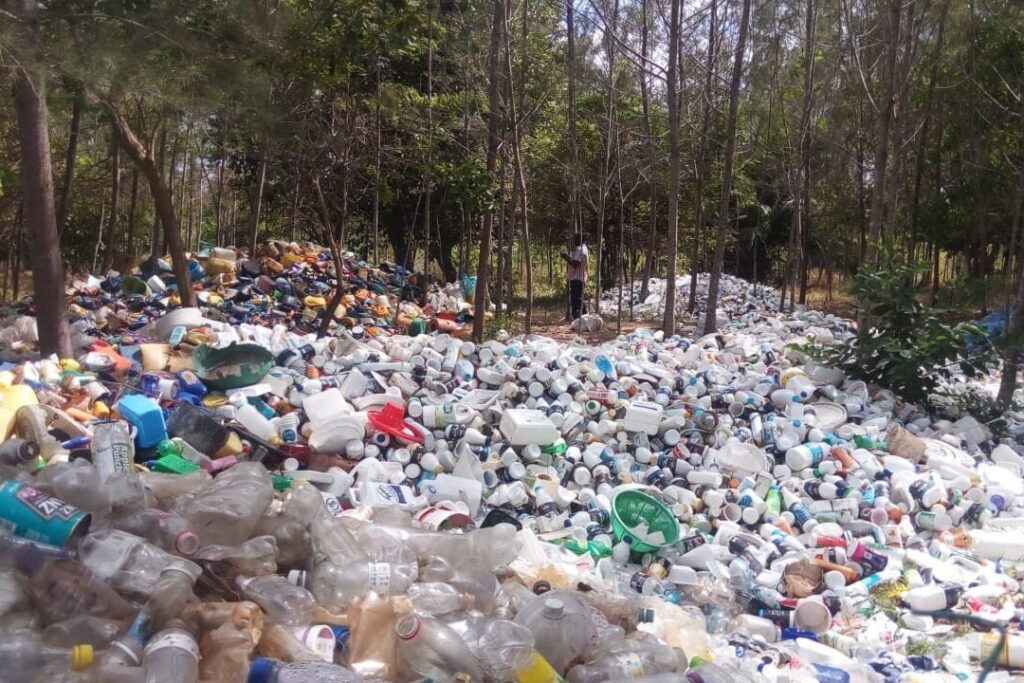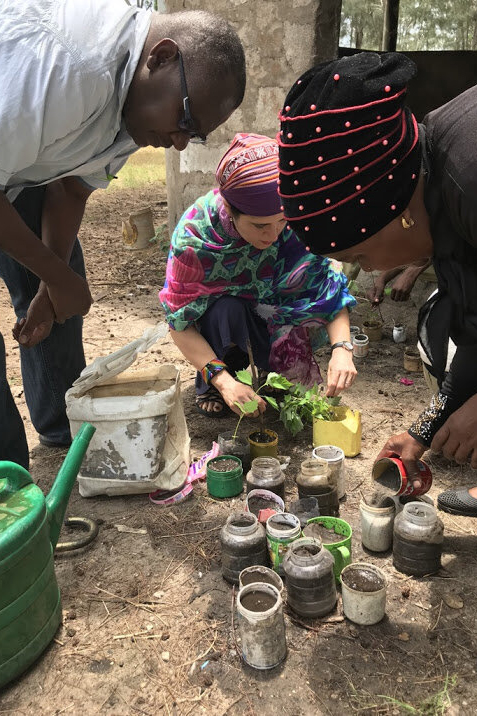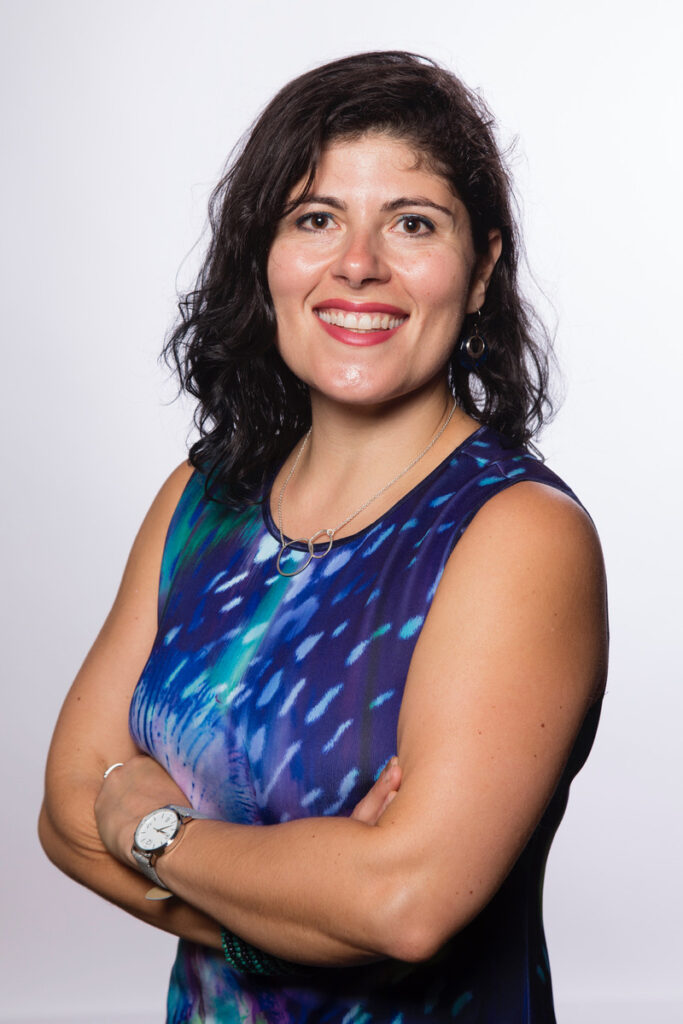Stanford pediatric arbovirologist Desiree LaBeaud’s quest to eradicate mosquito-borne diseases led to an unlikely culprit: plastic trash
In 2021, Stanford pediatrician and arbovirologist Desiree LaBeaud and her colleagues launched the nonprofit organization HERI-Kenya to reduce the spread of mosquito-borne diseases in Kenya by cleaning up the plastic waste where the insect breed.
The Aedes aegypti mosquito is a global havoc-wreaker, responsible for debilitating and deadly illnesses ranging from dengue fever to chikungunya and Zika virus. With a prodigious ability to multiply and a growing range extending from Africa and South America to much of Asia and many parts of the United States, it infects an estimated 400 million people annually.
No vaccines or therapeutics are available for these illnesses, so targeting the insect’s breeding grounds is critical to saving lives.
That’s why, in 2015, one of the first things Desiree LaBeaud did upon joining the Stanford Department of Pediatrics was apply for a Bechtel Faculty Scholar Awards in Pediatric Translational Medicine, which is provided through the Maternal & Child Health Research Institute’s Faculty Scholar program. She wanted to use the funds to teach Kenyan school children and community members about the mosquito breeding grounds around their homes. She had been studying mosquito-borne illness in Kenya for over a decade as a pediatric arbovirologist, a specialist who studies diseases caused by blood-sucking insects such as mosquitoes and ticks. She saw that dengue fever was sickening many Kenyan children due to a lack of awareness about its cause and how to prevent it.
Along with Stanford PhD student Jenna Forsyth and a Kenyan team of researchers from the Technical University of Mombasa, LaBeaud developed a week-long curriculum to teach the fourth- and fifth-grade students about the mosquitoes’ life cycle, disease causation and prevention. On the first day, they showed the children what mosquito larvae looked like and, for homework, encouraged them to be mosquito hunters and search for larvae in their community. The next morning, the children returned with a chorus of, “We found them! We found them!” But to the researchers’ surprise, the children reported that the larvae had been lurking mostly in piles of discarded plastic bottles, bags, buckets and tires outside their homes which harbored stagnant water – and not in large water containers as expected.
Up to this point, researchers and health professionals thought A. aegypti tended to breed in just a few types of containers, and that if they targeted those containers, they might be able to prevent disease. The children’s discovery turned this understanding on its head. The type of water-storing containers wasn’t the main problem – the water in the containers was the problem. Eighty-one percent of the larvae were breeding in “containers with no purpose” – primarily, the plastic trash where water could hide and stagnate.
“Jenna and I were astonished,” recalled LaBeaud, who is also a senior fellow at the Stanford Woods Institute for the Environment. “We realized we have to do something about all of this trash.”
Since then, LaBeaud has been on a quest to eliminate these manmade breeding grounds in Kenya. She is supported in her efforts by the Stanford Center for Innovation in Global Health, where she is a faculty fellow. The task is far from simple. Many residents do not see plastic as a problem and stigmatize trash collection as a profession. This, combined with a growing plastic industry and lack of recycling infrastructure, makes reducing plastic waste in Kenya a monumental challenge. To begin addressing these hurdles, she and her Kenyan colleagues this year launched a nonprofit organization, the Health and Environmental Research Institute (HERI) – Kenya, that seeks to tackle the plastic problem through policy, education, research, activism and business training. HERI’s ultimate goal is reducing mosquito-borne illness through community empowerment.
The nonprofit is the latest step by LaBeaud’s group in their ongoing efforts to translate scientific findings into meaningful improvements for the communities most impacted.
“From the beginning, we have wanted to make impactful change that actually improves health – because if it’s not, then what’s the point of doing it?” LaBeaud said.
Commitment born from experience
Having grown up in New Orleans, LaBeaud is no stranger to mosquitoes, but an incident at her grandparents’ house made a particular impression. When she was just a toddler playing in her grandparents’ backyard in Texas, a swarm of mosquitoes attacked her.

Sorted trash in Diani at Kwale Plastics Plus, an organization in Kwale County, Kenya that partners with the local government to promote recycling and reuse. (Image credit: HERI-Kenya Website)
“I was playing in the sprinkler in my bathing suit and they bit me all over my stomach,” LaBeaud recalled. While she did not contract an infectious disease like dengue or malaria, she was sick for days with fever and more than 100 inflamed welts.
Another encounter with mosquito-borne illness helped shape LaBeaud’s career trajectory. As a medical student at the Medical College of Wisconsin, LaBeaud was deeply interested in global health. In the early 2000s, she sought out one of the few pediatric Global Health track residencies at Rainbow Babies & Children’s (RBC) Hospital in Cleveland. During residency, she completed an international rotation in Laos during a monsoon season that led to a large outbreak of dengue fever.
“I took care of many sick children with dengue, and I saw a lot of children die from dengue,” she said. “That impacted me deeply, so when I came home, I wanted to do something about it.”
Through that experience, LaBeaud realized that in order to be more effective in global health settings, she needed infectious disease training. So when she was offered a pediatric infectious disease fellowship at RBC hospital, she accepted.
‘The night mosquito is the one that hurts’
While working in Kenya, she met Dr. Francis Mutuku, an entomologist at the Technical University of Mombasa, who became a lifelong collaborator and colleague. Their work led back to A. aegypti and dengue fever, which, she says, almost nobody in Africa was studying at the time.

LaBeaud and Kenyan colleague Dr. Francis Mutuku plant saplings in discarded plastic containers recovered during a trash cleanup with local schoolchildren in March 2018. (Image credit: Desiree LaBeaud)
“People were mainly studying malaria,” which is spread by another mosquito species, she said. “My work started out asking whether diseases like dengue fever were a problem in Africa. We discovered that they are.”
LaBeaud’s research found that oftentimes illness that was attributed to malaria may in fact have been dengue fever, since both diseases share some common symptoms, such as high fever, fatigue and malaise. Moreover, malaria can be detected in someone’s system even when it is not causing problems, and there are few diagnostic tools for dengue.
“If you’re only testing for malaria, you only diagnose malaria,” LaBeaud said.
As LaBeaud and her colleagues would later learn, many communities in Kenya often focused all their mosquito prevention efforts on the Anopheles mosquito that causes malaria. Residents didn’t understand that the main strategy to combat the night-biting Anopheles mosquito – the insecticide-treated bednet – is ineffective against A. aegypti, which bites during the day.
This misperception was underscored in interviews with local women and school children in Kenya: “The night mosquito is the one that hurts,” one woman commented. Another told them, “Mosquitoes also bite during the day but those that bite during the day are not harmful at all … harmful mosquitoes are available at night.”
Since there were no vaccines or treatments to help with dengue, LaBeaud and her colleagues realized that targeting the mosquitoes themselves was critical to mitigating the diseases they caused. So, in 2015, shortly after coming to Stanford as an associate professor in the department of pediatrics, LaBeaud and Forsyth secured the grant to educate the community about the A. aegypti mosquitoes.
The children’s discovery resulting from that grant took LaBeaud and her colleagues in a new direction: targeting plastic waste. They engaged school children in a trash cleanup that yielded 17,000 plastic containers like soda bottles, laundry detergent jugs and plastic food jars.
“And that’s when we realized, ‘Oh, there’s no formal plastic recycling in Kenya, so what are we going to do with all this plastic waste?” she said. They worked with the Kenya forestry service to plant 4,000 native tree seedlings in some of the repurposed containers, but were still left with tons of plastic trash. Faced with the choice of burning or burying the trash, they chose to bury it.
This led to a new undertaking: incentivizing plastic recycling in Kenya. They adopted social science strategies and interviewed community members, many of whom did not recognize trash as a vector for disease. The more LaBeaud and her colleagues looked, the more gaps they found, from policies that disincentivized recycling, to a lack of infrastructure, community awareness and safe business practices for yard shop operators, the businessmen who formed the informal recycling trade.
From research to action
With funding from the Building Out Vector-Borne Diseases in Sub Saharan Africa (BOVA) Network and support from Stanford Center for Innovation in Global Health’s new evidence-to-action program, the Action Lab for Planetary Health (ALPHA), they launched a strategic communications campaign to turn “Trash to Treasure,” sharing their findings on linkages between plastic trash and arbovirus transmission with policymakers in coastal Kenya. Their argument: Improving local waste management and recycling processes can not only serve as a public health intervention but can also mitigate environmental damage and strengthen the local economy.

HERI-Kenya volunteers collected more than 1,000 pounds of trash during a recent trash cleanup in the town of Ukunda in November 2021. (Image credit: HERI-Kenya Website)
“Since the problem is so complex, supporting the team in moving their research to action has required multiple strategies,” said Erika Veidis, the Stanford Center for Innovation in Global Health Planetary Health program manager. “So far, this has included organizing policy workshops, producing media content and developing strategic communications materials, including a short video, to build momentum for on-the-ground community engagement.”
To better address these complexities, LaBeaud, Mutuku and Bryson Ndenga, a research officer at the Center for Global Health Research at the Kenya Medical Research Institute (KEMRI) and a long-term research collaborator, decided a standalone organization was needed. In the spring of 2021, they launched their nonprofit organization, HERI-Kenya. To date, they’ve raised more than $120,000.
“Desiree and Francis have created a platform through HERI-Kenya that bridges a key gap in our community, a platform where communities can use science to address environmental health issues,” said Juma Nasoro, who lives in Kenya and was recently hired as HERI’s first program coordinator.
HERI’s goals include supporting and training entrepreneurs, especially women, to find alternative uses for plastic trash. They are looking to local examples, such as individuals who have found ways to convert plastic into building bricks, make art or create keychains to sell as souvenirs. They also plan to train doctors and nurses to educate the community around environmental health issues.
“One of our main motivations for the nonprofit is to educate and empower all of our community members so that they know about these mosquitoes, the diseases they cause and that trash is a problem. It’s difficult to do that as researchers. We needed another way to effect change,” LaBeaud said.
One of HERI’s inaugural activities was an urban trash cleanup in Diani, Kenya in the fall of 2021. Trash cleanups are rare in urban Kenya. A small group of about 20 HERI members began the effort but were soon joined by passersby, police officers and even the city’s municipal manager. While cleaning trash is a small part of HERI’s overall efforts, it created an incredible sense of morale and momentum, LaBeaud said.
“If we just get out there and start to do good things for the right reasons, others will join us,” she said.
Editor’s note: An earlier version of this story incorrectly referred to LaBeaud receiving a Bechtel Faculty Scholar Award. The correct name of the award is the Bechtel Faculty Scholar Awards in Pediatric Translational Medicine. It is provided through the Maternal & Child Health Research Institute’s Faculty Scholar program.
